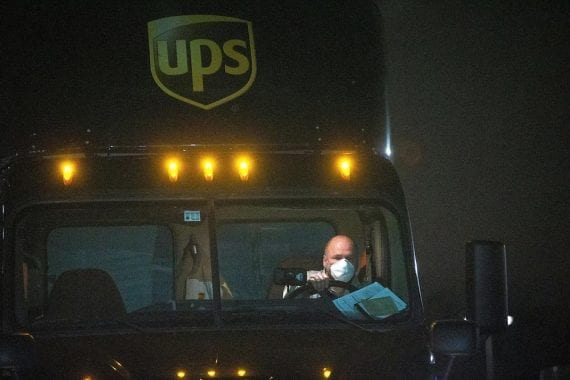Ecommerce sales are up, and shipping carriers such as USPS, UPS, and FedEx have responded admirably to demand in the face of coronavirus-induced shutdowns and restrictions.
That is the good news for ecommerce sellers. For many businesses, orders are strong, and delivery services remain reliable. Unfortunately, supply chains (international and domestic) have suffered, making it difficult for some ecommerce businesses to maintain inventory levels and take full advantage of the new demand. That is the bad news.
The Good News
“From the perspective of merchants, we’ve seen a large spike in overall volume,” said Mario Paganini, head of marketing for Shippo, a company that makes shipping integration software.
“Ecommerce is a rare bright spot amid challenging economic times. We’re seeing more traditionally offline businesses moving online along with increased order volume from existing ecommerce businesses,” Paganini said.
The recent spike in ecommerce orders is well documented. For example, on May 6, 2020, BigCommerce reported that “nearly two million ecommerce transactions were made through” its ecommerce platform the prior week. That is “32 percent more than Cyber 5 week 2019” — Thanksgiving, Black Friday, Cyber Saturday, Cyber Sunday, and Cyber Monday. It was the fifth consecutive week that transactions on the BigCommerce platform outpaced the peak of last year’s Christmas shopping season.
This is especially telling because unlike reports about how sales have soared for Amazon, Walmart, and other retail behemoths, many of BigCommerce’s customers fall into the small-and-midsized business category. Thus, a significant increase in transactions on the platform bodes well for SMB ecommerce.
More evidence came from Shippo.
“To put this into perspective, in April, 2020, the first full month where almost the whole country was under shelter in place, we saw an 80-percent increase in total orders and shipments across Shippo’s network of merchants,” said Paganini.
The leading domestic carriers in the United States have risen to the challenge.
“To their credit, USPS, UPS, and FedEx have all remained very reliable for domestic shipments amid Covid-19,” Paganini said. “Despite the well-reported delivery delays for Amazon Prime, we haven’t seen much to indicate degradation in speed or service from the actual shipping carriers.”
Carriers such as UPS have also helped fight Covid-19.

On April 1, this UPS truck delivered the first shipment of critical care ventilators in Olympia Fields, IL.
“In other words, a shipment quoted at a two-day arrival pre-Covid-19 is still arriving in two days during Covid-19. Even after announcing potentially extended delivery windows for domestic shipments a couple of weeks back, our data indicate that USPS delivery times for their top package services remain close to pre-Covid-19 averages. There have also been minor protocol changes to adapt to Covid-19, like waiving signature requirements. But overall domestic shipping remains strong,” Paganini said.
The Bad News
International shipping, however, has not been as consistent. And perhaps more importantly for many businesses, commercial shipping — how companies frequently receive inventory — has become less reliable during the pandemic.
“While [an increased number of orders] means more revenue for merchants, it also brings additional challenges for merchants and fulfillment partners,” Paganini said.
“We’ve heard from merchants that keeping up with inventory has been a challenge — both not having enough on hand to keep pace with volume and challenges in accelerating production on their supply chains, which are often international, amid Covid-19. Additionally, volume increases, as you might expect, have brought additional strain on fulfillment — the actual pick, pack, and ship,” Paganini continued.
“For context, many of our merchants start preparing mid-year for peak-season volume, holidays. We’ve seen many merchants hitting and even exceeding their normal Black Friday and Cyber Monday volumes consistently through April, forcing them to adapt quickly for greater capacity.”
In the worst cases, overseas inventory supplies are not arriving in time for some ecommerce sellers to meet demand, or the cost of shipping has significantly increased.
“The cost of moving that cargo is almost going up day by day,” said Paul Golland, owner of PG Logistics, a freight-forwarding business in Australia, according to a May 5, 2020, Wall Street Journal article. “You used to get a quote valid for 30 days. Now you’re getting it valid for 24 hours, because tomorrow the situation may change again.”
Impacting Ecommerce
“While specifics vary across merchants and industries, overall ecommerce is seeing more purchases and more total buyers than ever amid Covid-19. For us, the big question is, what will things look like when we eventually return to normal?” said Shippo’s Paganini.
“Right now, we’re seeing buyers that previously did not purchase online making purchases from ecommerce merchants out of necessity. Additionally, buyers who were already familiar with ecommerce are purchasing more than before.
“This presents an interesting challenge and opportunity for ecommerce merchants: How do they retain these customers when we return to normal? For us, it’s more critical than ever for merchants to deliver stellar customer experiences, including great support and communications, detailed order tracking, easy returns, and great branded experiences.”







